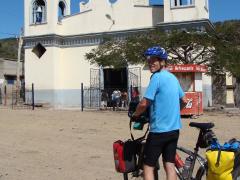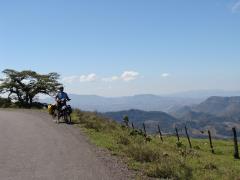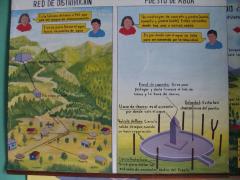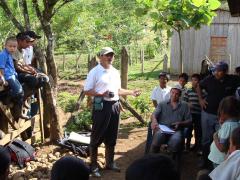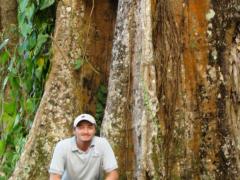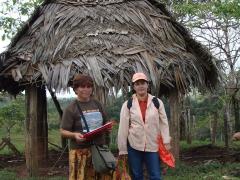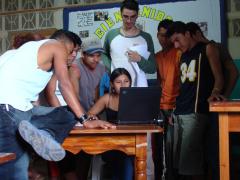Inuvik to Ushuaia
The ride from San Marcos to Jinotega
Let me take a moment and tell you about one of the villages we rode through on the way from Estelí to Jinotega, Nicaragua this week. San Marcos is a strange little village where everything has been built around a lone church. The houses in the village form a huge empty dirt circular void around the church with nothing in between. It reminded me of an old ghost town but there was people in front of every house, just sitting and watching the strange gringos ride through their village.
It was around high noon as we rode in. In the bell tower were two young boys ringing the church bell, calling to everyone that the funeral service was about to begin. The only restaurant closed up just seconds before we rode up (probably because of the funeral). Everyone was strolling toward the church and those that were not just sat and stared at us, hungry we rode on to another part of the village that had promise for lunch time nourishment and knowing that we had some hard climbs ahead. With just a small printed sign above a door, I stopped to ask where we could find something to eat. An older man rushed off to find his aging wife. Bingo, there was some food on the stove which they would gladly serve us. We still do not know if this was an official place that served food but they did for us. They were first concerned that we would not like the food they had to offer- beans, squash cooked in the beans and corn tortillas and some kind of milky fruit like drink. We assured them we eat everything, several times. read more here... lee mas aquí... »
The saint of San Rafael
On the struggle out of the valley of San Marcos, a truck stopped and offered us a lift. It was driven by an Italian Catholic priest in traditional robes and two sisters with similar brown habits. They smiled so nicely as they told me about their lovely town of San Rafael and their special church. They encouraged me to visit San Rafael which I did the next day.
I took a bus out to San Rafael and did agree that is was a wonderful village. I got a private tour of Tepeac by the groundskeeper who had great love for this special place. According to an article published in the Nica News 21 (March 1999) “The most outstanding figure in the history of San Rafael is the Italian priest, Father Odorico D'Andrea. From his arrival in 1953 to his death in 1996, Father Odorico achieved virtual sainthood among the people of San Rafael and the surrounding communities. His image, a smiling, warm, obviously kind man in plain brown robes, can be seen in nearly every home, business and vehicle in the town. "It's so sad," said one community member, "that you weren't here to know him." Among his achievements are a formidable health clinic, a library, several neighborhoods for the poor, and the beautifying of the church.
The latter feat is truly impressive. Pastel-colored windows admit a calming light in which to view the many bright murals, bas-reliefs and shrines. read more here... lee mas aquí... »
Guatemala South to Nicaragua Pictures
Here is a slideshow of the pictures from our re-start in Guatemala at the beginning of 2008 to the middle of Nicaragua. You can view all the pictures in full size and with their captions on flickr and see the show at flickr here. You can see all our photos at flickr.com/photos/hobobiker.
Agua Para La Vida: We're in Rio Blanco, Nicaragua
Last Tuesday we rode into Rio Blanco, in the rural, rural lowlands of Nicaragua, to visit an organization we'd been in contact with for a few years, so we'll be in Rio Blanco for a week or so. Agua Para La Vida (Spanish for "Water for Life") was founded 19 years ago toward the end of the dark war years when a CU Berkeley engineering professor came to this out-of-the way place for a visit with another charitable organization and found that there was no potable water at all in the village he was visiting. Being an engineer, he thought in terms of how to solve their problem with some water engineering, and he brought volunteers to the village over a period of a couple of years to put in a water system, complete with collection at the water source (a spring) and piping to distribution points. From that time to now APLV has grown into a modest but effective little organization, having completed more than 50 projects in the little villages mostly in the Rio Blanco area.
APLV has an integrated approach to water: They don't want to just deliver a water project, because without the other aspects of healthy living it doesn't do much, and won't be cared for properly anyway. They work with the community to make sure that each household member gets trained in a variety of health management techniques, including handwashing, proper storage and handling of drinking water, trash management, and the like. read more here... lee mas aquí... »
APLV: Home-Grown Leadership
Esteban Cantillano is one of the amazing success stories of APLV. In 1993 he was a campesino living in a little, remote village where APLV was developing a potable water project. He was elected the coordinator by the community, so was responsible for all the interface with the community. But he asked a pile of questions of the brigade from UC Berkeley that was putting in the system! He wanted to know about everything. He was eventually invited to join the first class of the "Potable Water Technical School", a technical high school program, but protested that he had only finished the 6th grade. They said "well, try it out - we'll take you on probation." That was in 1993. Needless to say, he finished with honors (and later went back and did his 7th-10th grade education!) and became one of the pillars of APLV. He has served in the technical/design role he was trained for, as the social coordinator (who does the contact with the village, local government, landowners, and the like), and is now in charge of the office here in Rio Blanco. He seems to know everybody, and to know everything about every project ever constructed by APLV.
Esteban is just one example of the depth of leadership that we've found here. All but one of the workers here is Nicaraguan, and they have a combined total of decades of experience with the organization. read more here... lee mas aquí... »
Agua Para La Vida: The Community does all the work!
(We'll have pictures and updates to this article in a couple of days.)
When a community gets interested in a water project and approaches APLV, it has to go through a number of steps before the project can become a reality. One of the first steps is to commit to doing all of the unskilled labor and provide hospitality to the APLV technical staff when they are onsite. Although APLV provides the materials and engineering, the community does an extremely difficult job - each family normally commits to between 42 and 62 days of labor for the project. You can imagine what that means to people who have very little to take that much time out of the course of a project (6 months to a year). The families build their own outhouses, and the men do all the trenching and the concrete work. This is a pile of work, as the piping often runs for 6-9 miles (10-15 kilometers).
If you're interested in more information on Agua Para La Vida or would like to contribute, they have an excellent website at APLV.org where you can get the whole scoop or make a contribution. It takes just $30,000 to $60,000 to fund a complete village project that may benefit 100-200 families, complete with potable water, outhouses, community health training, and reforestation planning. It is even possible to fund an entire project (and then visit for the inauguration of the project), but of course most of us give in smaller chunks. read more here... lee mas aquí... »
APLV: Reforestation and Environmental Work
The second day we were in Rio Blanco at APLV in Rio Blanco Fadir Rojas, APLV's reforestation engineer, took us for a hike up into the beautiful Cerro Musún wilderness reserve right next to the town, where he used to work as an engineer and ranger. We spent the afternoon climbing up into virgin forest to a beautiful waterfall called Cascada Las Golondrinas (the swallows). As we walked along we chatted about his responsibilities with APLV and the growing importance of reforestation within the goals of the organization.
Fadir is from a purely campesino family in the dry, heavily populated western part of the country. His parents barely went to school - perhaps to the first grade - and can't really read, but they pushed education in their family and Fadir is one of four university graduates in his family. He succeeded in getting full scholarships for his university education at the national university and is now, at 27, one of the elite young leaders of Nicaragua.
When Fadir came to APLV he found that their vision of reforestation was too limited: They understood the idea of using forest management to project the water source from contamination, but the integrated management plan did not include enough emphasis on protecting the watershed itself from deforestation. read more here... lee mas aquí... »
APLV: Promoting Health and Sanitation
The organization we visited in Rio Blanco, Nicaragua, Agua Para La Vida, believes in an integrated approach to making a difference in a community. So they don't just drop a potable water system and disappear. They try to set up a program that will be self-sustaining and which can make a long-term difference in the health and welfare of the community. For that reason they always provide an outhouse (actually constructed by the family), and have a health team in charge of evaluating the community's needs, training them in appropriate health practices, and monitoring the water quality of the installed system.
Lilian Bando and Gregoria Espinoza have been working for APLV in their role as health promoters for a dozen years, and they still find that their educational role is the most important thing they do.
When they arrive at a new project, it's quite common to find that there are few or no outhouses (of course there are no sewage or water systems, so outhouses, where they exist, are the workhouses of sanitation in rural Central America). And it's also common to find that the entire community is ignorant of basic concepts like handwashing after going to the bathroom, proper management of drinking water, appropriate disposal of trash, and the like. read more here... lee mas aquí... »
APLV: The Potable Water Technical School
Agua Para La Vida is committed to truly sustainable solutions, and they have demonstrated it in the most significant way by actually starting a school for Potable Water Technicians.
The initial little tiny project that APLV did back in the 1980's, of course, was mostly done by brigades of volunteers coming down for a few weeks at a time. But when you do that, your project has little hope of being maintainable, because there is inadequate in-country expertise. To counter this, APLV started up the "Escuela Tecnica para Agua Potable", or Technical School for Potable Water back in the 1990's. It's a fully accredited 2+ year class involving every aspect of potable water design and development, including the theory and practice of planning and engineering the delivery systems and including everything else that APLV does with a project. Three classes have now graduated, and the fourth class (of 8 students) is about halfway through. For this class, 70 students from all over Nicaragua applied for the full-ride scholarship (including room, board, and tuition), and just the 8 slots were available. But what an education they get. They come out with all the mathematics and engineering to do technical work on water systems, and have a fully-accredited "Bachelor" degree, similar to an honors technical high school degree. Their presence in various organizations throughout Nicaragua means that projects don't have to spend money on high-priced consultants to do the work that these specialized technicians can do. APLV's "ETAP" school is the only school graduating water technicians in Nicaragua. read more here... lee mas aquí... »

